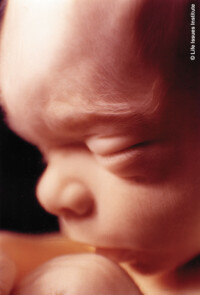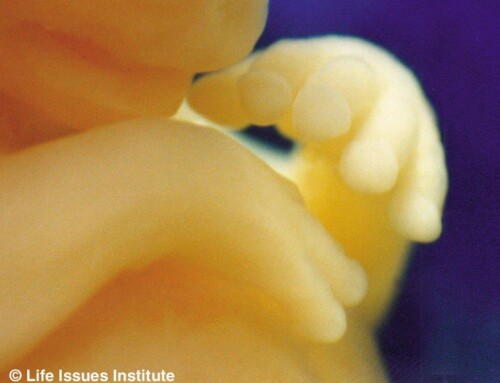The fetus’s environment is disturbed by sounds, light, and touch and he responds to these disturbances by moving.
Sound:
Until the late nineteenth century babies were thought to be born deaf as well as dumb. In fact the inner ear of the fetus is completely developed by mid-pregnancy, and the fetus responds to a wide variety of sounds.
He is surrounded by a constant very loud noise in the uterus–the rhythmical sound of the uterine blood supply punctuated by the noises of air passing through the mother’s intestine. Loud noises from outside the uterus such as the slamming of a door or loud music reach the fetus and he reacts to them. The fetus also responds to sounds in frequencies so high or low that they cannot be heard by the adult human ear, which suggests that sensory pathways other than the ear are implicated. Movements of the fetus tend to be inhibited by low frequencies and increased by high frequencies.
Doppler ultrasound used for monitoring fetal heart rate appears to provoke fetal activity. Ultrasound used for imaging does not produce a response by the fetus. After birth a mother tends to hold her baby on the left breast. There the infant can hear his mother’s heartbeat, which provides the same type of rhythm that was present in the uterus and which appears to have a calming effect. Recordings of the adult heartbeat or of the noise in the uterus have a calming effect on infants when they are played to them.

unborn child – 20 weeks after conception
Vision:
Muscles within the orbit are present very early in pregnancy, and the fetus’s eyes move when he changes position and during sleep. In late pregnancy some light penetrates through the uterine wall and amniotic fluid, and fetal activity has been shown to increase in response to bright light.
In pretem infants changes in the electroencephalogram occur in response to light, and the repeated flashing of a light will quieten babies.
Response to Touch:
The fetus can touch parts of his body with his hands and feet, and the umbilical cord also touches all parts of his body. Early in pregnancy the fetus tends to move away from objects he touches; later he moves towards them.
Nine weeks after conception the baby is well enough formed for him to bend his fingers round an object in the palm of his hand. In response to a touch on the sole of his foot he will curl his toes or bend his hips and knees to move away from the touching object. At 12 weeks he can close his fingers and thumb and he will open his mouth in response to pressure applied at the base of the thumb.
At first when his hands touch his mouth the fetus turns his head away, though his mouth opens. Later the fetus may turn his head towards his hands and even put a finger into his open mouth and suck it. This reflex-the rooting reflex-persists after birth. Then it is usually the mother’s nipple that touches the baby in this way.
Spontaneous Movements:
Although the fetus starts making spontaneous movements at about seven weeks after conception, mothers do not usually feel their babies moving until about 16 to 21 weeks. The types of movements include slow squirmy movements, sharp kicks, and small rhythmic kicks. The squirming tends to increase during pregnancy, while the rhythmic kicks continue at a constant rate from the fifth to the ninth month. The sharp kicks increase up to the seventh month and then diminish.
Some of these movements show a cyclical pattern, which might be related to the fetus’s sleep pattern. Later in pregnancy the fetus tends to sleep at the same time as his mother.
The fetus’s level of activity increases when the mother is under emotional stress. If the stress is prolonged there is a corresponding increase in the fetus’s movements–up to 10 times their normal level. The fetus’s activity also seems to be increased when the mother is tired.
At 11 weeks after conception the fetus starts to swallow the surrounding amniotic fluid and to pass it back in his urine. He can also produce complex facial expressions and even smile. Towards the end of pregnancy the fetus’s chest wall expands and contracts, as if he were breathing. These movements, which occur about 70{a886d2509afb02fdbd678c9c9cbef29e9b4ac8f1454580a0bf53ee67e764b753} of the time, are often interrupted by sighs and hiccups. A decrease in fetal chest and limb movements occurs a few days before fetal death.
Pain:
The fetus needs to be heavily sedated by sedating the mother before intrauterine manipulations such as transfusions. Otherwise he will move away from the needle, which cannot then be inserted into the peritoneal cavity. Fetal heart rate and movement increase for a few minutes after tactile stimuli during amniocentesis. The fetus settles down again within a few minutes of the procedure’s ending.
The changes in heart rate and increase in movement suggest that these stimuli are painful for the fetus. Certainly it cannot be comfortable for the fetus to have a scalp electrode implanted in his skin, to have blood taken from the scalp, or to suffer the skull compression that may occur even with sponteous deliveries. It is hardly surprising that infants delivered by difficult forceps extraction act as if they have a severe headache.
HB Valman, MD, FRCP, is a consultant paediatrician, Northwick Park Hospital and Clinical Research Centre, Harrow. J.F. Pearson, MD, FRCOG, is senior lecturer and consultant obstetrician and gynaecologist, Welsh National School of Medicine, Cardiff.
Extracted from:
The British Medical Journal, 26 January, 1980, “The first year of Life” by H.B Valman and J.F. Pearson.
Action Life Online Article


